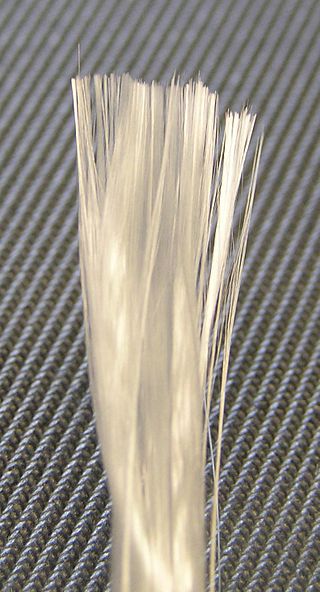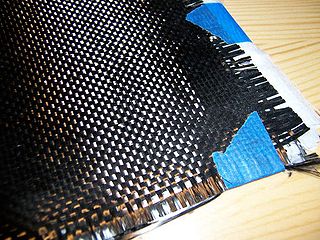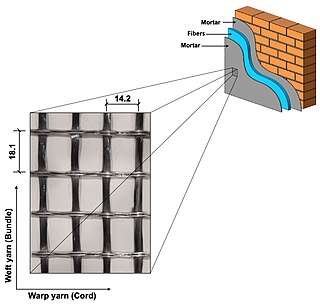Related Research Articles

Reinforced concrete, also called ferroconcrete, is a composite material in which concrete's relatively low tensile strength and ductility are compensated for by the inclusion of reinforcement having higher tensile strength or ductility. The reinforcement is usually, though not necessarily, steel bars (rebar) and is usually embedded passively in the concrete before the concrete sets. However, post-tensioning is also employed as a technique to reinforce the concrete. In terms of volume used annually, it is one of the most common engineering materials. In corrosion engineering terms, when designed correctly, the alkalinity of the concrete protects the steel rebar from corrosion.

Fiber or fibre is a natural or artificial substance that is significantly longer than it is wide. Fibers are often used in the manufacture of other materials. The strongest engineering materials often incorporate fibers, for example carbon fiber and ultra-high-molecular-weight polyethylene.

Glass fiber is a material consisting of numerous extremely fine fibers of glass.

A composite material is a material which is produced from two or more constituent materials. These constituent materials have notably dissimilar chemical or physical properties and are merged to create a material with properties unlike the individual elements. Within the finished structure, the individual elements remain separate and distinct, distinguishing composites from mixtures and solid solutions. Composite materials with more than one distinct layer are called composite laminates.

Carbon fibers or carbon fibres are fibers about 5 to 10 micrometers (0.00020–0.00039 in) in diameter and composed mostly of carbon atoms. Carbon fibers have several advantages: high stiffness, high tensile strength, high strength to weight ratio, high chemical resistance, high-temperature tolerance, and low thermal expansion. These properties have made carbon fiber very popular in aerospace, civil engineering, military, motorsports, and other competition sports. However, they are relatively expensive compared to similar fibers, such as glass fiber, basalt fibers, or plastic fibers.
Fiberglass or fibreglass is a common type of fiber-reinforced plastic using glass fiber. The fibers may be randomly arranged, flattened into a sheet called a chopped strand mat, or woven into glass cloth. The plastic matrix may be a thermoset polymer matrix—most often based on thermosetting polymers such as epoxy, polyester resin, or vinyl ester resin—or a thermoplastic.

Rebar, known when massed as reinforcing steel or steel reinforcement, is a steel bar used as a tension device in reinforced concrete and reinforced masonry structures to strengthen and aid the concrete under tension. Concrete is strong under compression, but has low tensile strength. Rebar significantly increases the tensile strength of the structure. Rebar's surface features a continuous series of ribs, lugs or indentations to promote a better bond with the concrete and reduce the risk of slippage.
Fibre-reinforced plastic is a composite material made of a polymer matrix reinforced with fibres. The fibres are usually glass, carbon, aramid, or basalt. Rarely, other fibres such as paper, wood, boron, or asbestos have been used. The polymer is usually an epoxy, vinyl ester, or polyester thermosetting plastic, though phenol formaldehyde resins are still in use.

Metallic fibers are manufactured fibers composed of metal, metallic alloys, plastic-coated metal, metal-coated plastic, or a core completely covered by metal.
Fiber-reinforced concrete or fibre-reinforced concrete (FRC) is concrete containing fibrous material which increases its structural integrity. It contains short discrete fibers that are uniformly distributed and randomly oriented. Fibers include steel fibers, glass fibers, synthetic fibers and natural fibers – each of which lend varying properties to the concrete. In addition, the character of fiber-reinforced concrete changes with varying concretes, fiber materials, geometries, distribution, orientation, and densities.

"Technical textile" refers to a category of textiles specifically engineered and manufactured to serve functional purposes beyond traditional apparel and home furnishing applications. These textiles are designed with specific performance characteristics and properties, making them suitable for various industrial, medical, automotive, aerospace, and other technical applications. Unlike conventional textiles used for clothing or decoration, technical textiles are optimized to offer qualities such as strength, durability, flame resistance, chemical resistance, moisture management, and other specialized functionalities to meet the specific needs of diverse industries and sectors.

Textile-reinforced concrete is a type of reinforced concrete in which the usual steel reinforcing bars are replaced by textile materials. Instead of using a metal cage inside the concrete, this technique uses a fabric cage inside the same.
Carbon fiber-reinforced polymers, carbon-fibre-reinforced polymers, carbon-fiber-reinforced plastics, carbon-fiber reinforced-thermoplastic, also known as carbon fiber, carbon composite, or just carbon, are extremely strong and light fiber-reinforced plastics that contain carbon fibers. CFRPs can be expensive to produce, but are commonly used wherever high strength-to-weight ratio and stiffness (rigidity) are required, such as aerospace, superstructures of ships, automotive, civil engineering, sports equipment, and an increasing number of consumer and technical applications.
Three-dimensional composites use fiber preforms constructed from yarns or tows arranged into complex three-dimensional structures. These can be created from a 3D weaving process, a 3D knitting process, a 3D braiding process, or a 3D lay of short fibers. A resin is applied to the 3D preform to create the composite material. Three-dimensional composites are used in highly engineered and highly technical applications in order to achieve complex mechanical properties. Three-dimensional composites are engineered to react to stresses and strains in ways that are not possible with traditional composite materials composed of single direction tows, or 2D woven composites, sandwich composites or stacked laminate materials.

Tailored fiber placement (TFP) is a textile manufacturing technique based on the principle of sewing for a continuous placement of fibrous material for composite components. The fibrous material is fixed with an upper and lower stitching thread on a base material. Compared to other textile manufacturing processes fiber material can be placed near net-shape in curvilinear patterns upon a base material in order to create stress adapted composite parts.
Textile-reinforced mortars (TRM) (also known as fabric-reinforced cementitious mortars are composite materials used in structural strengthening of existing buildings, most notably in seismic retrofitting. The material consists of bidirectional orthogonal textiles made from knitted, woven or simply stitched rovings of high-strength fibres, embedded in inorganic matrices. The textiles can also be made from natural fibres, e.g. hemp or flax.

In materials science, reinforcement is a constituent of a composite material which increases the composite's stiffness and tensile strength.
The reinforcement of 3D printed concrete is a mechanism where the ductility and tensile strength of printed concrete are improved using various reinforcing techniques, including reinforcing bars, meshes, fibers, or cables. The reinforcement of 3D printed concrete is important for the large-scale use of the new technology, like in the case of ordinary concrete. With a multitude of additive manufacturing application in the concrete construction industry—specifically the use of additively constructed concrete in the manufacture of structural concrete elements—the reinforcement and anchorage technologies vary significantly. Even for non-structural elements, the use of non-structural reinforcement such as fiber reinforcement is not uncommon. The lack of formwork in most 3D printed concrete makes the installation of reinforcement complicated. Early phases of research in concrete 3D printing primarily focused on developing the material technologies of the cementitious/concrete mixes. These causes combined with the non-existence of codal provisions on reinforcement and anchorage for printed elements speak for the limited awareness and the usage of the various reinforcement techniques in additive manufacturing. The material extrusion-based printing of concrete is currently favorable both in terms of availability of technology and of the cost-effectiveness. Therefore, most of the reinforcement techniques developed or currently under development are suitable to the extrusion-based 3D printing technology.

3D textiles are three-dimensional structures made with different manufacturing methods such as weaving, knitting, braiding, or nonwoven, or made with alternative technologies. 3D textiles are produced with three planar geometry, opposed to 2D textiles that are made on two planes. The weave in 2D textiles is perpendicular. The yarn is fed along two axis: length (x-axis) and width (y-axis), while 3D textiles also have a perpendicular weave, but they have an extra yarn with an angular feeding (z-axis) which creates thickness. 3D weaves are orthogonal weave structures, multilayer structures, and angle interlocks. 3D textiles have more manufacturing opportunities, various properties, and a broader scope of applications. These textiles have a wide range of applications, but they are most commonly used where performance is the primary criterion, such as technical textiles. Composite materials, manufacturing is one of the significant areas of using 3D textiles.

A fiber-reinforced cementitious matrix (FRCM) is a reinforcement system composed by fibers embedded in an inorganic-based matrix, usually made by cement or lime mortar.
References
- ↑ "Research surveys for basalt rock quarries | Basalt Projects Inc. | Engineering continuous basalt fiber and CBF-based composites". Basalt Projects Inc. Retrieved 2017-12-10.
- ↑ De Fazio, Piero (2011). "Basalt fibra: from earth an ancient material for innovative and modern application" (PDF). Energia, Ambiente e Innovazione. 3: 89–96. Archived from the original (PDF) on 2021-09-18. Retrieved 2021-09-08.
- ↑ Schut, Jan H. (August 2008). "Composites: Higher Properties, Lower Cost". www.ptonline.com. Retrieved 2017-12-10.
- ↑ Ross, Anne (August 2006). "Basalt Fibers: Alternative To Glass?". www.compositesworld.com. Retrieved 2017-12-10.
- ↑ "Basalt Fibers from continuous-filament basalt rock". basalt-fiber.com.
- ↑ Soares, B.; Preto, R.; Sousa, L.; Reis, L. (2016). "Mechanical behavior of basalt fibers in a basalt-UP composite". Procedia Structural Integrity. 1: 82–89. doi: 10.1016/j.prostr.2016.02.012 .
- ↑ Choi, Jeong-Il; Lee, Bang (30 September 2015). "Bonding Properties of Basalt Fiber and Strength Reduction According to Fiber Orientation". Materials. 8 (10): 6719–6727. Bibcode:2015Mate....8.6719C. doi: 10.3390/ma8105335 . PMC 5455386 . PMID 28793595.
- ↑ "Some aspects of the technological process of continuous basalt fiber". novitsky1.narod.ru. Retrieved 2018-06-21.
- ↑ "Basalt Continuous Fiber". Archived from the original on 2009-11-03. Retrieved 2009-12-29.
- ↑ Ibrahim, Arafa M.A; Fahmy, Mohamed F.M; Wu, Zhishen (2016). "3D finite element modeling of bond-controlled behavior of steel and basalt FRP-reinforced concrete square bridge columns under lateral loading". Composite Structures. 143: 33–52. doi:10.1016/j.compstruct.2016.01.014.
- ↑ "Basalt fiber". basfiber.com (in Russian, English, German, Korean, and Japanese). Retrieved 2018-06-21.
- ↑ L. Fahrmeir, R. Künstler, I. Pigeot, G. Tutz, Statistik – Der Weg zur Datenanalyse. 5. Auflage, Springer-Verlag, Berlin/Heidelberg, (2005).
- ↑ (the main work is the book "Konstruieren mit Faser-Kunststoff-Verbunden" of Helmut Schürmann)
- ↑ B. Jungbauer, M. Romano, I. Ehrlich, Bachelorthesis, University of Applied Sciences Regensburg, Laboratory of Composite Technology, Regensburg, (2012).
- ↑ Albarrie - BASALT FIBER
- ↑ Neuvokas
- ↑ Henderson, Tom (December 10, 2016). "Neuvokas raises the bar on manufacture of rebar". Crain's Detroit Business. Retrieved 17 December 2018.